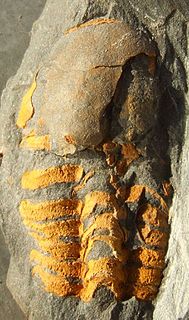 W
WAgraulos Hawle & Corda 1847, is a genus of trilobites that lived during the Middle Cambrian in North America and Europe, particularly the Czech Republic.
 W
WAtrypa is a genus of brachiopod with shells round to short egg-shaped, covered with many fine radial ridges, that split further out and growthlines perpendicular to the costae and 2-3 times wider spaced. The pedunculate valve is a little convex, but tends to level out or even become slightly concave toward the anterior margin. The brachial valve is highly convex. There is no interarea in either valve. Atrypa was a cosmopolitan and occurred from the late Lower Silurian (Telychian) to the early Upper Devonian (Frasnian). Other sources expand the range from the Late Ordovician to Carboniferous, approximately from 449 to 336 Ma. A proposed new species, A. harrisi, was found in the trilobite-rich Floresta Formation in Boyacá, Colombia.
 W
WAulacopleura is a genus of proetid trilobite that lived from the Middle Ordovician to the Middle Devonian. Some authors may classify this group as subgenus Otarion (Aulacopleura). The cephalon is semicircular or semielliptical, with border and preglabellar field. The glabella is short, with or without defined eye ridges connecting it with eyes of variable size. Spines at the rear outer corners of the cephalon are present, typically reaching back to the 2nd to 4th thorax segment. The 'palate' is not connected to the dorsal shield of the cephalon. The cephalon is pitted, or has small tubercles. The thorax has up to 22 segments. The pleural ends are usually rounded. The pygidium is small (micropygous), with an even margin. A. koninckii had a modern type of compound eye.
 W
WBirmanites is a genus of trilobites in the order Asaphida, family Asaphidae.
 W
WBojoscutellum is a genus of trilobites in the order Corynexochida family Styginidae.
 W
WCaleidocrinus is a genus of sea lily that lived during the Middle and early Upper Ordovician in what is now the Czech Republic and Wales.
 W
WCampylocephalus is a genus of eurypterid, a group of extinct aquatic arthropods. Fossils of Campylocephalus have been discovered in deposits ranging from the Carboniferous period in the Czech Republic to the Permian period of Russia. The generic name is composed of the Greek words καμπύλος (kampýlos), meaning "curved", and κεφαλή (kephalē), meaning "head".
 W
WCochleosaurus is a name of a tetrapod belonging to Temnospondyli, which lived during the late Carboniferous period. The great abundance of its remains have been found in the Kladno Formation of the Czech Republic, near Nýřany in Central Europe and in the Morien Group of Nova Scotia in North America. It was a creature of medium size, measuring 120-160 centimeters. It is believed that Cochleosaurus was a semiaquatic ambush predator, hunting like modern crocodiles. Czech paleontologist Antonin Fritsch named the genus in 1885 in reference to the spoon-shaped processes on the supra-occipital bones at the back of the skull.
 W
WColpocoryphe is a genus of trilobites in the family Calymenidae.
 W
WConchicolites is a fossil genus of cornulitid tubeworms. Their shells lack vesicular wall structure and have a smooth lumen. They are externally covered with transverse ridges. Some species have spines. They usually occur as encrusters on various shelly fossils. Their fossils are known from the Late Ordovician to the Devonian.
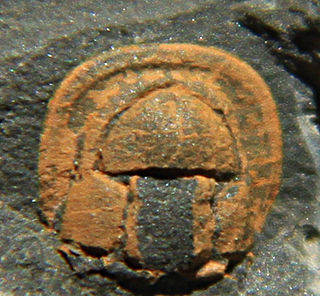 W
WCondylopyge Hawle and Corda (1847) is a genus of agnostid trilobite that lived during the latest Early and early Middle Cambrian, in what are today Canada, Czech Republic, England and Wales, France, Germany, Italy, Morocco, the Russian Federation, Spain, Turkey and Sweden. It can easily be distinguished from all other Agnostida because the frontal glabellar lobe is notably wider than the rear lobe. It belongs to the same family as Pleuroctenium but the frontal glabellar lobe does not fold around the rear lobe, as it does in the latter. The genus is long ranging, possibly spanning the early Cambrian Terreneuvian Series in Nuneaton, central England into at least Drumian strata at various locations elsewhere.
 W
WConocoryphe is a genus of primarily eyeless trilobites belonging to the family Conocoryphidae. They lived during the Middle Cambrian period, about 505 million years ago. These arthropods lived on the sea bottom (epifaunal) and lived off dead particulate organic matter.
 W
WCothurnocystis is a genus of small enigmatic echinoderms that lived during the Ordovician. Individual animals had a flat boot-shaped body and a thin rod-shaped appendage that may be a stem, or analogous to a foot or a tail. Fossils of Cothurnocystis species have been found in Nevada, Scotland, Czech Republic, France and Morocco.
 W
WCummingella is a genus of proetid trilobite in the family Phillipsiidae that lived from the earliest Carboniferous until the last species' extinction in the Middle Permian. Fossils have been found in corresponding marine strata of Western Europe, the United Kingdom and the United States.
 W
WCyclopygidae is a family of asaphid trilobites from the Ordovician. Cyclopygids had an extratropical distribution, and there is evidence that they lived in darker parts of the water column. Cyclopygids are characterized by enlarged eyes, with a wide angle of view, both horizontal and vertical, reminiscent of the eyes of dragonflies. These typically touch the glabella directly on the side. Cyclopygids all lack genal spines, but Symphysops carries a forward directed frontal spine on the glabella. It is presumed that at least the members of the genus Pricyclopyge swam upside down and had bioluminescent organs on the third thorax segment. Cyclopygids had between 7 and 5 thorax segments, a wide and stout axis, and short side lobes.
 W
WDeiphon is a distinctive genus of Silurian phacopid trilobites of the family Cheiruridae found in Western and Central Europe, and in Central and Eastern United States. The type species, D. forbesi, from England, Bohemia, and Sweden, was discovered and described by the French paleontologist, Joachim Barrande in 1850.
 W
WDindymene is an extinct genus of trilobites in the order Phacopida. It contains two species, D. didymograpti, and D. hughesiae.
 W
WDiplovertebron is an extinct genus of embolomere that lived in the Late Carboniferous period (Moscovian), about 310 million years ago. Diplovertebron was a medium-sized animal, around 50 cm in length. Members of the genus inhabited European Carboniferous swamps in what is now the Czech Republic. They were closely related to larger swamp-dwelling tetrapods like Proterogyrinus and Anthracosaurus. However, Diplovertebron were much smaller than these large, crocodile-like creatures. Known from a single species, Diplovertebron punctatum, this genus has had a complicated history closely tied to Gephyrostegus, another genus of small, reptile-like amphibians.
 W
WDiscosauriscus was a small seymouriamorph which lived in what is now Central and Western Europe in the Early Permian Period. Its best fossils have been found in the Broumov and Bacov Formations of Boskovice Furrow, in the Czech Republic.
 W
WEchinosphaerites is a genus of rhombiferan cystoid echinoderms that lived in the Early to Middle Ordovician of North America and Europe.
 W
WEllipsocephalus Zenker, 1833, is a genus of blind Cambrian trilobite, comprising benthic species inhabiting deep, poorly lit or aphotic habitats. E. hoffi is a common trilobite mainly from central Europe.
 W
WEusarcana is a genus of eurypterid, an extinct group of aquatic arthropods. Fossils of Eusarcana have been discovered in deposits ranging in age from the Early Silurian to the Early Devonian. Classified as part of the family Carcinosomatidae, the genus contains three species, E. acrocephalus, E. obesus and E. scorpionis, from the Silurian-Devonian of Scotland, the Czech Republic and the United States respectively.
 W
WFavosites is an extinct genus of tabulate coral characterized by polygonal closely packed corallites. The walls between corallites are pierced by pores known as mural pores which allowed transfer of nutrients between polyps. Favosites, like many corals, thrived in warm sunlit seas, feeding by filtering microscopic plankton with their stinging tentacles and often forming part of reef complexes. The genus had a worldwide distribution from the Late Ordovician to Late Permian.
 W
WFurca is an extinct genus of Marrellomorph arthropod known from the Sandbian stage of the Czech Republic. At least three distinct species have been described although they may all be synonyms of the type species, Furca bohemica. A tentative additional species, "Furca mauretanica": was proposed for specimens discovered in Morocco, but this species remains a nomen nudum until formally published.
 W
WGeragnostus is a genus of very small agnostid trilobites whose fossils are found Ordovician-aged marine strata from Eurasia, North America and Argentina.
 W
WGoniatites is a genus of extinct cephalopods belonging to the family Goniatitidae, included in the superfamily Goniatitaceae. Hibernicoceras and Hypergoniatites are among related genera.
 W
WHalysites is an extinct genus of tabulate coral. Colonies range from less than one to tens of centimeters in diameter, and they fed upon plankton.
 W
WHolopea is an extinct genus of fossil sea snails, Paleozoic gastropod mollusks in the family Holopeidae.
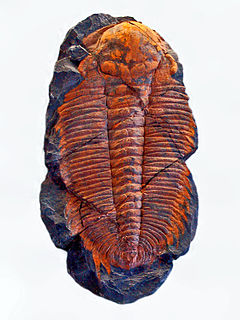 W
WHydrocephalus is an extinct genus of redlichiid trilobite that was very common during the Middle Cambrian of Eurasia and North America, which lasted from 508 to 497 million years ago. This trilobite is up to 20 cm long and more widely built than others of the time. In comparison to other members of its family, its glabella appears swollen.
 W
WKodymirus is a problematic genus of Early Cambrian arthropod, known from the Czech Republic, which bears some resemblance to the eurypterids, aglaspidids and chelicerates. It is part of a small and low-diversity fauna endemic to the area, which dwelt in brackish waters.
 W
WLeptaena is an extinct genus of mid-sized brachiopod that existes from the Dariwilian epoch to the Emsian epoch, though some specimens have been found in strata as late in age as the Tournasian epoch. Like some other Strophomenids, Lepteana were epifaunal, meaning they lived on top of the seafloor, not buried within it, and were suspension feeders.
 W
WLichenoides is an extinct genus of echinoderms that lived during the Middle Cambrian in what is today the Czech Republic.
 W
WMacroscaphites is an extinct cephalopod genus included in the Ammonoidea that lived during the Barremian and Aptian stages of the Early Cretaceous. Its fossils have been found throughout most of Europe and North Africa.
 W
WMakowskia is an extinct genus of discosauriscid seymouriamorph known from the early Permian of Boskovice Furrow, in the Czech Republic. It was first named by Jozef Klembara in 2005 and the type species is Makowskia laticephala. The generic name honors Alexander Makowsky for describing the first specimens of discosauriscids from the Boskovice Furrow, and the specific name means “broad” + “head”. Makowskia is known only from one specimen, the holotype SNMZ 26506, a skull and anterior portion of postcranial skeleton. A phylogenetic analysis places Makowskia as the sister taxon to Spinarerpeton.
 W
WOdontomachus paleomyagra is an extinct species of formicid in the ant subfamily Ponerinae known from a Miocene fossil found in Europe.
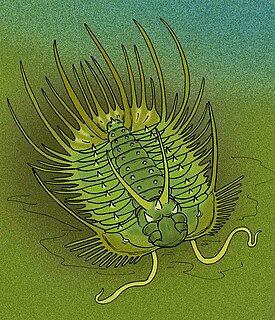 W
WOdontopleura is a genus of spinose odontopleurid trilobite in the family Odontopleuridae, and is the type genus of that family and of Odontopleurida. The various species are found in Upper Ordovician to Middle Devonian marine strata throughout the world. The best studied fossils are of the type species, O. ovata, from the Wenlock-aged Liteň Formation in Loděnice, in Bohemia, Czech Republic, and, southeastern Gotland, of Sweden.
 W
WPhalagnostus is a genus of small trilobites, in the order Agnostida. It lived during the Middle Cambrian, in what are now Canada, China, the Czech Republic, Denmark, England, France, the Russian Federation, Wales, Sweden, and possibly the United States (Vermont). The headshield is almost entirely effaced and wider than the tailshield. The pygidium is also very effaced, but the ovate pygidial axis is well defined and a border furrow is also present.
 W
WPlacoparia is a genus of trilobites of average size that lived during the late Lower to the early Upper Ordovician on the paleocontinents Gondwana, Avalonia and Laurentia, now the Czech Republic, France, Germany, Morocco, Portugal, Spain and Wales. Its headshield is semi-circular to rectangular with rounded frontal corners. It lacks eyes, but eye ridges are present. The fact that the facial sutures are opisthoparian is an exception in the otherwise proparian Cheirurina. The thorax has 11 or 12 segments, with the axis slightly wider than the ribs to its sides. The tips of the pleurae are free, which resembles an old-fashion central heating radiator. The axis in the small tailshield consists of four rings and a minute endpiece. The four pleurae end in spatulate spines that fit to corresponding indentations in the cephalon.
 W
WPlanolites is an ichnogenus found throughout the Phanerozoic that is made during the feeding process of worm-like animals. The traces are generally small, 1–5 mm (0.039–0.197 in), unlined, and rarely branched, with fill that differs from the host rock.
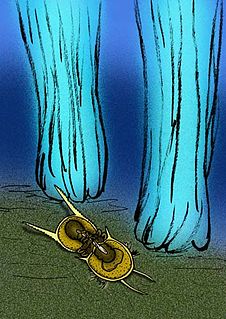 W
WPleuroctenium is an agnostid trilobite belonging to the family Condylopygidae. The genus occurs in Middle Cambrian (Drumian) strata of Canada, the Czech Republic, England and Wales, France, and Sweden.
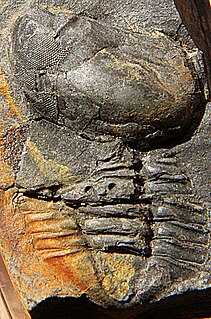 W
WPricyclopyge is a genus of trilobites assigned to the family Cyclopygidae that occurs throughout the Ordovician. Pricyclopyge had an extratropical distribution, and there is evidence that it lived in darker parts of the water column. Pricyclopyge has huge eyes, an inverted pear-shaped glabella, six thorax segments, with on the 3rd two small discs. Pricyclopyge is known from what are today China, the Czech Republic, France, and the United Kingdom.
 W
WPseudonaraoia is a genus of small marine arthropods within the family Naraoiidae, that lived during the late Middle Ordovician period. The only species presently known is Pseudonaraoia hammanni.
 W
WPsilophyton is a genus of extinct vascular plants. Described in 1859, it was one of the first fossil plants to be found which was of Devonian age. Specimens have been found in northern Maine, USA; Gaspé Bay, Quebec and New Brunswick, Canada; the Czech Republic; and Yunnan, China. Plants lacked leaves or true roots; spore-forming organs or sporangia were borne on the ends of branched clusters. It is significantly more complex than some other plants of comparable age and is thought to be part of the group from within which the modern ferns and seed plants evolved.
 W
WRafinesquina is an extinct genus of large brachiopod that existed from the Darriwilian to the Ludlow epoch.
 W
WSelenopeltis is an extinct genus of odontopleurid trilobites in the family Odontopleuridae.
 W
WSolenodonsaurus is an extinct genus of reptiliomorphs that lived in what is now Czech Republic, during the Westphalian stage.
 W
WSphaeragnostus is an extinct genus from a well-known class of fossil marine arthropods, the trilobites. It can be recognized by having two thorax segments, a totally effaced headshield, while the tailshield although effaced, has a clear furrow parallel to its border, and a short, convex, subcircular axis. It lived during the Ordovician.
 W
WSymphysops is a genus of trilobites of average size, belonging to the Cyclopygidae family. It had a cosmopolitan distribution and lived from the Middle to the Upper Ordovician. It has been found in Canada, China, the Czech Republic (Bohemia), Iran, Ireland, Kazakhstan, Poland, Morocco, Spain, Scotland and Wales. The name Symphysops refers to the fused eyes, common to the species of this genus. Some (sub)species of the cyclopygid genera Cyclopyge and Pricyclopyge share this character, but Symphysops uniquely combines the merged eye with a frontal thorn on the head and the "lower eyelid".
 W
WTrimerocephalus is a genus of eyeless trilobites from the order Phacopida, family Phacopidae. It lived during the final stage of the Devonian, the Famennian, and became extinct at the end of this stage, together with all other trilobites with the exception of some Proetida. It can be found in Australia, the Czech Republic, France, Germany, Iran, Kazakhstan, Morocco, Poland, the Russian Federation (Urals), Spain, and the United Kingdom (England).
 W
WTrinodus is a very small to small blind trilobite, a well known group of extinct marine arthropods, which lived during the Ordovician, in what are now the Yukon Territories, Virginia, Italy, Czech Republic, Poland, Denmark, Sweden, Svalbard, Ireland, Scotland, Wales, Iran, Kazakhstan and China. It is one of the last of the Agnostida order to survive.
 W
WZeliszkella is a genus of trilobite in the order Phacopida, with species of average size. Species are known from the Middle and Upper Ordovician and have been found in the Czech Republic, France, Morocco, Portugal and Spain.